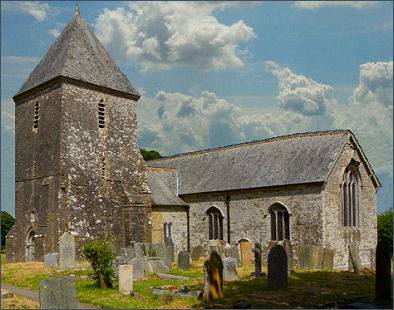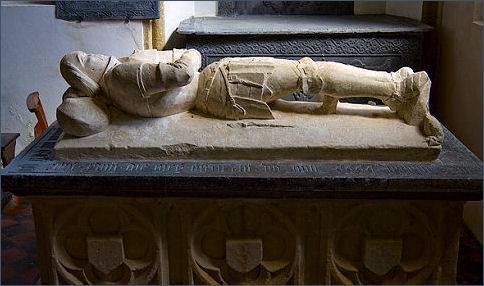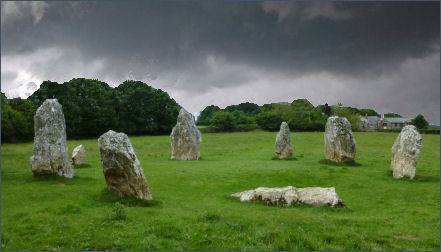Duloe
OS Grid ref:- SX 233 585
 Duloe lies around four miles (6 kilometrezs) to the south of the town of Liskeard. Duloe is a Celtic place name but its meaning is uncertain. Some believe it means two rivers, being situated between the East and West Looe rivers, but others point out that Dhu - Loo means Black Pool and until recent times there was a dark pool in the hollow near the original village well.
Duloe lies around four miles (6 kilometrezs) to the south of the town of Liskeard. Duloe is a Celtic place name but its meaning is uncertain. Some believe it means two rivers, being situated between the East and West Looe rivers, but others point out that Dhu - Loo means Black Pool and until recent times there was a dark pool in the hollow near the original village well.
The village church is dedicated to St Cuby and St Leonard and dates to the early medieval era, it stands on a circular mound which was probably an Iron Age Fort.
St Cuby, or Cybi as he was known in Wales, was born in Cornwall in the fifth century, he was the son of Salomon, a 'warrior prince', generally thought to have been a King of Cornwall, and was the nephew of St Nonna. In early life, he went on a pilgrimage to Rome and Jerusalem. He trained for the priesthood in Ireland, and was consecrated as a bishop, before he arrived home to find that his father was dead and he was King of Cornwall. Cuby declined the throne and, instead, travelled through his kingdom, preaching to the people and building churches at Duloe, Tregony, Cubert and Landulph and established churches in Wales, and was the founder of the monastery of Holyhead in Anglesey.
The church's plan is unusual in Cornwall since the tower is at the end of the south transept. The tower was built in thirteenth century, its upper stage was added later in the Perpendicular style. However this stage was removed in 1861.
 The north aisle continues eastwards to form a chancel aisle which is grander in style than the rest of the building and was the family chapel of the influential Colshull family. The chapel contains a fine monument to Sir John Colshull (died 1483). The effigy of Sir John, in full armour, lies on a slab of elvan stone on top of a tomb chest ornamented with shields and at the west end a crucifixion. John Colshull was the son of another John Colshull, a London vintner and royal servant who within months after the execution for treason of Chief Justice Tresillian had married his widow Emmeline, née Huish, by whom he acquired her family's lands in Cornwall and Devon
The north aisle continues eastwards to form a chancel aisle which is grander in style than the rest of the building and was the family chapel of the influential Colshull family. The chapel contains a fine monument to Sir John Colshull (died 1483). The effigy of Sir John, in full armour, lies on a slab of elvan stone on top of a tomb chest ornamented with shields and at the west end a crucifixion. John Colshull was the son of another John Colshull, a London vintner and royal servant who within months after the execution for treason of Chief Justice Tresillian had married his widow Emmeline, née Huish, by whom he acquired her family's lands in Cornwall and Devon
The parclose screen bears coats of arms connected with the Colshulls and may be made up of parts of a rood screen. A font-like bowl in the church, dating from the sixth century, was taken from nearby St. Cuby's Holy Well.
St. Cuby's Well Holy Well is situated half a mile away from the church towards Looe, it is covered by a modern well house. The inner chamber is ancient and the steps down into the water might indicate that it was a place of baptism. The holy well lies on the right hand side of the road to Looe, past Duloe Manor.
In the springtime Duloe Woods in the Looe Valley, are covered with a spectacular carpet of bluebells and make a great location for a walk.
Duloe Stone Circle
OS grid reference- SX 2350 5830
 Duloe is perhaps best known for it's stone circle, which stands in a field some 300 yards from the village church.
Duloe is perhaps best known for it's stone circle, which stands in a field some 300 yards from the village church.
The unique Bronze Age circle, which is oval in shape, is the smallest in Cornwall, with a diameter of less than twelve metres.
It consists of irregular white quartz blocks set in a pattern of alternating large and small stones. The stones themselves are large, the largest being eight feet high and weighs about 12 tons. The monument dates back to about 2000 BC.
Duloe Stone Circle was restored in the nineteenth century, the restoration included the removal of a hedge that once ran through the centre of the circle and incorporated two of the original stones. During the restoration, a Bronze Age ribbon handled urn was discovered which contained cremated human bone.